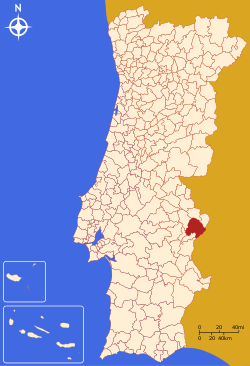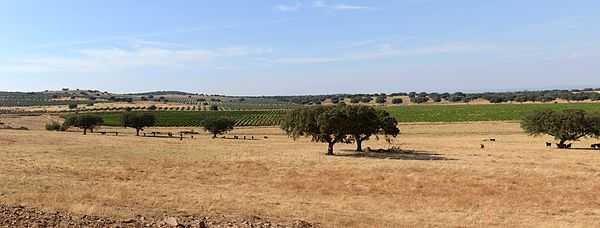Elvas
| Elvas | |||
|---|---|---|---|
| Municipality | |||
| |||
 | |||
| Coordinates: 38°52′N 7°09′W / 38.867°N 7.150°WCoordinates: 38°52′N 7°09′W / 38.867°N 7.150°W | |||
| Country |
| ||
| Region | Alentejo | ||
| District/A.R. | Portalegre | ||
| Government | |||
| • Mayor | José Almeida (PS) | ||
| Area | |||
| • Total | 631.3 km2 (243.7 sq mi) | ||
| Population | |||
| • Total | 23,691 | ||
| • Density | 36/km2 (90/sq mi) | ||
| Parishes (no.) | 11 | ||
| Municipal holiday |
January 14 | ||
| Website | http://www.cm-elvas.pt | ||
Elvas (Portuguese pronunciation: [ˈɛɫvɐʃ]) is a Portuguese municipality, an episcopal city and frontier fortress of Portugal, located in the district of Portalegre in Alentejo. It is situated about 230 km east of Lisbon, and about 15 km west of the Spanish fortress of Badajoz, by the Madrid-Badajoz-Lisbon railway. The city itself has a population of 18,106.[1]
Elvas is among the finest examples of intensive usage of the trace italienne (star fort) in military architecture, and is a World Heritage Site since 30 June 2012. The inscribed site name is Garrison Border Town of Elvas and its Fortifications.
History
Elvas lies on a hill 8 km northwest of the river Guadiana. It is defended by seven bastions and the two forts of Santa Luzia and Nossa Senhora da Graça. Its late Gothic cathedral, which has also many traces of Moorish influence in its architecture, dates from the reign of Manuel I of Portugal (1495–1521). A 6 km long aqueduct supplies the city with pure water; it was begun early in the 15th century and completed in 1622. For some distance it includes four tiers of superimposed arches, with a total height of 40 m. The surrounding lowlands are very fertile, and Elvas is known for its olives and plums, the last-named being exported, either fresh or dried, in large quantities. Brandy is distilled and pottery manufactured in the city. The fortress of Campo Maior, 15 km to the northeast, is famous for its siege by the French and relief by the British under Marshal Beresford in 1811, an exploit commemorated in a ballad by Sir Walter Scott.
It was wrested from the Moors by Afonso I of Portugal in 1166; but was temporarily recaptured before its final occupation by the Portuguese in 1226. In 1570 it became an episcopal see. From 1642 until modern times it was the chief frontier fortress south of the Tagus; and it twice withstood sieges by the Spanish, in 1658 and 1711. The French under Marshal Junot took it in March 1808 during the Peninsular War, but evacuated it in August, after the conclusion of the Convention of Sintra.

Parishes
- Ajuda, Salvador e Santo Ildefonso
- Alcáçova
- Assunção
- Barbacena
- Caia e São Pedro
- Santa Eulália
- São Brás e São Lourenço
- São Vicente e Ventosa
- Terrugem
- Vila Boim
- Vila Fernando
Sister cities
-
 Badajoz, Extremadura, Spain
Badajoz, Extremadura, Spain -

 Olivenza, Extremadura, Spain and the same time Alentejo, Portugal
Olivenza, Extremadura, Spain and the same time Alentejo, Portugal
Gallery
-

A pillory in the city of Elvas
-

Elvas aqueduct
-

Elvas castle
-

Another angle of the castle
-

Elvas Station
-

Cathedral interior
References
- ↑ UMA POPULAÇÃO QUE SE URBANIZA, Uma avaliação recente – Cidades, 2004 Nuno Pires Soares, Instituto Geográfico Português (Geographic Institute of Portugal)
 This article incorporates text from a publication now in the public domain: Chisholm, Hugh, ed. (1911). Encyclopædia Britannica (11th ed.). Cambridge University Press
This article incorporates text from a publication now in the public domain: Chisholm, Hugh, ed. (1911). Encyclopædia Britannica (11th ed.). Cambridge University Press
| |||||
| ||||||||||||||||||||||||||

